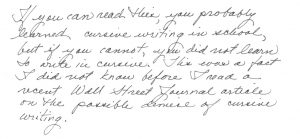Why I Still Teach Cursive Writing
Many schools nowadays do not teach cursive based on their own research and standards. It is sad to know how most schools especially in the US eliminated teaching cursive since it isn’t included in the Common Core State Standards. However, in some Asian countries, cursive is still being taught at the age of 7-8. In Japan they start teaching cursive in the junior high school level. As teacher at Yokohama Christian School, I love teaching cursive not because it was taught to me in 2nd grade but because of its benefits to the learning process. Studies show that learning to write in cursive can improve brain development in the areas of thinking, language and working memory. Cursive writing increases comprehension and participation. It also helps students in spelling words by connecting consonants and vowels to form a word. Cursive writing develops motor skills and reinforces learning. In the later part, cursive will help students read legal documents; connect to the past when reading scripts written in cursive and for them to write their own signature.
Let us hear from teachers around the world regarding their thoughts in teaching cursive writing:
Definitely, calligraphy or cursive writing must be taught to pupils especially those in enrolled in the foundation years (Grades 1 to 3) to help them improve their handwriting and grammatical capabilities and develop potentials in presenting outputs through the works of hand. In reality, pupils are now adept into using computers in complying school requirements, thus having lesser time to practice handwriting. In effect, pupils and students forget correct word spelling and commit a lot of errors in sentence construction in terms of grammar and punctuations. – Dr. Nover M., Philippines
Well, it’s not bad to still teach cursive writing in schools because in a legal document we have to use cursive for signing to avoid forgery. Aside from that when it comes to taking notes it’s easier to write in cursive. Also, as I have read, our histories are written in cursive so it’s good if we can be able to read the original text.
It’s true that cursive was not usually use these days but it doesn’t mean that we have to abandon it. We still have to learn to add it to our skills. Maybe in the future we can use cursive writing as a secret code. Ms. Carol A., Thailand
Even though today’s digital age is making pen and paper seem so outdated, I think we, teachers, should not take an opportunity to teach cursive writing.
I believe that it’s important to incorporate kinaesthetic activity in language arts. Handwriting engages the brain in learning.
Also, teaching cursive writing gives an opportunity for integrated learning. Children can strengthen their fine-motor skills, be artistic and creative, learn the history/culture of cursive letters, and gain other way to express their ideas and voices.
So, I think children should be introduced to the cursive letters. –Ms. Maki H, Japan/USA
They stopped cursive in American schools for about 20 years. In the last 4 years they’ve brought it back. I think it helps strengthen the knowledge of “connectedness” of English words. – Ms. Debra S., China
Yes, I agree that cursive should be taught at a school as an additional skill because it enhances the writing skills of the students. This adds aesthetic form of their writing and don’t you think it is good for warding off people who likes forge signatures?” – Ms. Bona Lee S., Vietnam
A lot of people may find cursive to be not so important nowadays but it always has a benefit to some as long as we look at the positive side of it. Who knows that this might help any parent or teacher having problem at home or at school regarding their child/students poor handwriting.


